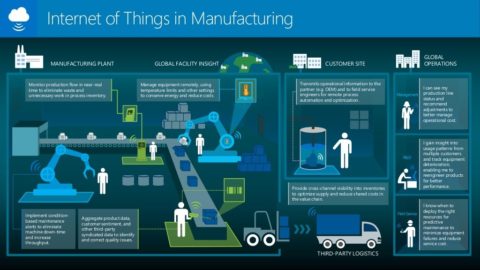Table of Contents
It’s not a secret that innovations promote business growth. And you have probably read a lot about such new technologies like augmented reality, virtual reality, machine learning, the internet of things, etc., and how they can really make a difference for any company in the manufacturing industry.
We don’t want to waste your time and repeat what you already know. Instead, we’ll focus on specific examples of software for manufacturers and how the manufacturing processes can benefit from the custom manufacturing software development.
MRP software
MRP stands for Material Requirements Planning and this is one of the most critical production management software for every manufacturer and business operations. In short, MRP systems is the production planning and scheduling software aimed at the efficient management of manufacturing processes. As the name suggests, these software solutions deal with material requirements and resources.
With the help of this business software, company officers can monitor the availability of materials required for manufacturing processes like production and products that are ready for delivery. This tool lets them determine what and how many items are needed, as well as when they are needed, providing the option of warehouse management. Hence, it becomes possible to maintain the lowest sufficient amount of products in warehouses and stores, which significantly reduces the level of production losses.
Employee tracking apps
This type of manufacturing operations software is especially useful for large plants. GPS systems integrated into these applications allows the company’s management to track employees’ locations and routes. The benefit is twofold. Foremost, it improves the safety at the plant, as company officials have an opportunity to provide more accurate and relevant instructions in case of an emergency.
And, secondly, employee tracking applications help managers gain better control over the processes as they can monitor all the activity at the plant. In other words, with these applications, the company’s management can easily make sure that each employee does the right tasks and timely spot the bottlenecks if such occur.
CRM, ECM, and ERP software
CRM, ECM, and ERP software solutions are helpful for any business, not just those from the manufacturing industry.
CRM solution
CRM stands for Customer Relationship Management. This software collects and records all information related to the company’s customers (e.g. contacts, news, previous communications, etc.). Thus, the main benefit it brings to business processes operating in the manufacturing industry is a much faster close of the deals since sales teams have an opportunity to promptly receive real-time data about clients.
ECM software
ECM is Enterprise Content Management. Basically, it’s a document management software that makes the work with corporate content much more efficient. With an ECM system, employees across a company can easily share, edit and sign digital documents.
ERP system for manufacturing
Now, what is ERP software? ERP stands for Enterprise Resource Planning system. ERP systems are a comprehensively integrated system that helps a business manage all its resources, from cash to raw materials and products. It may also include a CRM system, so, depending on your business needs, you can either develop the latter separately or as an integral part of enterprise resource planning systems. You can also enable ERP integration with other software pieces. Here is what modules typical ERP systems usually cover:
ERP software is tasked with automating the manual workflows within the manufacturing processes to eliminate the need for much effort from human resources, and delays in business operations, and to ensure reaching the set plans and goals monthly and annually.
Again, it’s essential that you opt for bespoke software development because off-the-shelf solutions are not tailored to your business needs and, thus, usually are not efficient enough.
Industrial IoT systems
Although such technologies like the internet of things and artificial intelligence are relatively new, nowadays, there is already a myriad of ways they are utilized in the industrial world. Here are a few examples of software every manufacturer may want to have:
- Real-time monitoring systems. Thanks to the IoT sensors, as well as advanced analytics, it’s possible to constantly monitor how every machine is functioning even at large plants. IoT systems also allow for monitoring of the supply chain (e.g. available materials, work in progress, etc.) and, thus, when they are integrated into inventory management software for the manufacturing operations, the inventory control improves exponentially. So the real-time monitoring systems can help the company’s management gain better control over the production and detect even the smallest errors before they turn into colossal problems.
- Self-repairing equipment. As mentioned, IoT along with machine learning made it possible to create software that allows for automatic identification of issues occurring in the equipment. But what is more, such issues may be addressed unattended, i.e. without the necessity of human intervention.
- Digital twins. These are virtual models of physical buildings, products, systems, and processes that are connected with original objects with the sensors allowing manufacturers to track the changes in assets and optimize their performance.
According to Business Intelligence research, the number of machines connected with IoT systems in the manufacturing industry will hit the number of 923 million by 2020.
Demand forecasting tools
The demand in the manufacturing industry is influenced by many factors such as an economic and political situation in a country, export and import rates, surplus or deficit of resources on the market, etc. For this reason, it’s always fluctuating that often causes waste and losses in production.
The innovative solution lies in the software that is based on big data. The main objective of demand forecasting tools is to help company officers make accurate predictions about the situation in the market and manage production forces accordingly. And, as you may know, big data is all about advanced analytics. It allows manufacturing companies to avoid significant losses and, thus, promotes continuous business growth.
Besides systems making precise predictions of how many products have to be produced, big data tools are also integrated into other software like enterprise resource planning aimed at automation. Specifically, it’s used to evaluate supply chain management risks, improve quality assurance, make custom product design and enhance production processes in general.
Conclusion
Nowadays, manufacturers of all kinds just cannot ignore innovations and the opportunities they bring. It’s not that much about convenience or following fancy trends, it’s about staying competitive and growing in the new digitized world. In this article, we mentioned only a few possible applications of new technologies in the manufacturing industry, but there are indeed many more them. So when it comes to a decision related to custom manufacturing software, for instance, between MRP and ERP systems as the best manufacturing solution for your business, the selection depends on your specific business requirements and production process.
If you’re looking for a software development company to create a tech solution that will bring your manufacturing business to the next level, the experienced Altamira team is ready to help. We have an extensive experience in digital transformation and building custom software systems for many businesses, including manufacturer software solutions. Let’s schedule a quick call, so we could find out more about your manufacturing process and help you define which variant (MRP vs ERP) suits your company more.





